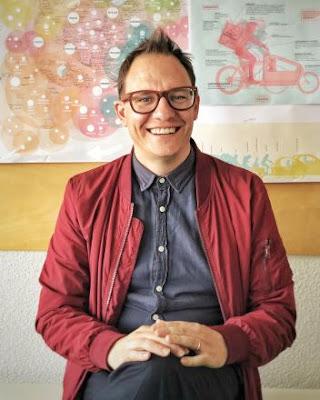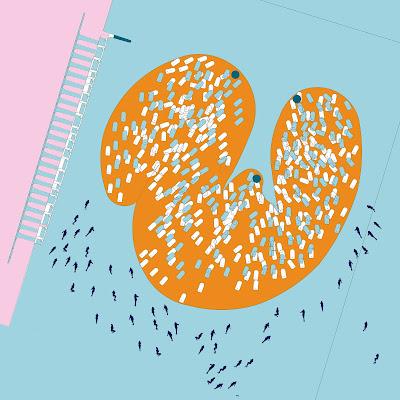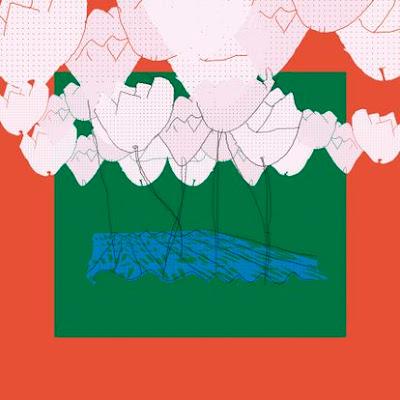
¿Es posible cartografiar el yo, aventurar un plano, concebir un volumen o una arquitectura? Sin duda Sigmund Freud fue pionero a la hora de teorizar un modelo que ha sido copiado y manipulado hasta el extremo, pero hasta hoy nunca había tenido en la mano una propuesta que nos regalara un conjunto de construcciones afectivas con rigor arquitectónico y una novedosa narrativa. Nos la ofrece Mauro Gil-Fournier en su libro “Las casas que me habitan” donde desgrana una serie de propuestas de arquitectura interior con sus correspondientes diseños, planos y alzados a modo de recorrido biográfico por las avenidas interiores del autor.
Si a la hora de elegir una casa como vivienda nos tomamos la molestia de ver muchas para poder elegir o de plantear un nuevo diseño desde cero con la ayuda de un profesional, si hacemos números para ver si nos la podemos permitir y empeñamos ahorros y grandes esfuerzos para conseguirla, ¿no sería razonable hacer lo mismo con los espacios interiores que habitamos permanentemente?
Este libro nos abre la puerta a una nueva forma de concebir, diseñar e imaginar las casas interiores que vamos atravesando en nuestra biografía personal. Dota de una nueva dimensión al arte de proyectar y construir edificios por un lado y al de entender y sanar la psicología y el alma humana por el otro.
La gran originalidad y creatividad de esta visión tienen un valor incuestionable en una época basada en un permanente corta-pega. El material que nos ponen por delante es totalmente novedoso y tremendamente práctico. Somos invitados a mirarnos a nosotros mismos y a los que nos rodean de una nueva manera y a devenir en aparejadores de nuestras oquedades.
Desarrollar nuevas maneras de mirar y construir el mundo es una facultad antigua que nos sigue siendo imprescindible. No se trata solo de destacar implementando proyectos más grandes, más modernos o más caros. En una tesitura de decrecimiento global que nos obligará a limitar los abusos materiales con los que amenazamos al planeta es una gran noticia que nos recuerden que el desarrollo sostenible ha de basarse en generar ideas y propuestas no materiales. Este libro es un maravilloso ejemplo.

Emotional architecture.
Is it possible to map the self, to venture a map, to conceive a volume or an architecture? Sigmund Freud was undoubtedly a pioneer when it came to theorising a model that has been copied and manipulated to the extreme, but until today we have never had in our hands a proposal that gives us a set of affective constructions with architectural rigour and a novel narrative. Mauro Gil-Fournier offers it to us in his book "Las casas que me habitan" (The houses that inhabit me), in which he describes a series of proposals for interior architecture with their corresponding designs, plans and elevations in the manner of a biographical journey through the author's interior avenues.
If when it comes to choosing a house as a dwelling we have the task to see many in order to choose or to propose a new design from scratch with the help of a professional, if we crunch the numbers to see if we can afford it and pledge savings and great efforts to get it, would it not be reasonable to do the same with the interior spaces that we inhabit permanently?
This book opens the door to a new way of conceiving, designing and imagining the interior homes we go through in our personal biography. It gives a new dimension to the art of designing and constructing buildings on the one hand and to the art of understanding and healing psychology and the human soul on the other.
The great originality and creativity of this vision are of unquestionable value in an age based on a permanent cut-and-paste. The material that is put before us is totally new and tremendously practical. We are invited to look at ourselves and those around us in a new way and to become riggers of our own hollows.
Developing new ways of looking at and constructing the world is an ancient faculty that remains indispensable to us. It is not just a matter of standing out by implementing bigger, more modern or more expensive projects. In a situation of global degrowth that will force us to limit the material abuses with which we threaten the planet, it is great news to be reminded that sustainable development must be based on generating non-material ideas and proposals. This book is a wonderful example.

情感架构。
机器翻译,抱歉有错误。
是否有可能绘制自我地图,冒险制定一个计划,构思一个体积或建筑?当谈到理论化的模式时,西格蒙德-弗洛伊德无疑是一个先驱者,他的理论已经被复制和操纵到了极致,但直到今天,我们手中还没有一个提案,给我们提供了一套具有建筑学上的严谨性和新颖叙述的情感建构。毛罗-吉尔-福尼尔在他的《我居住的房子》(Las casas que me habitan)一书中向我们展示了这一点,他在书中描述了一系列室内建筑的建议及其相应的设计、平面图和立面图,其方式是通过作者的室内通道的传记之旅。
如果在选择房子作为住所时,我们花了很多精力去看,以便做出选择,或在专业人士的帮助下从头开始提出新的设计,如果我们做了数字,看看我们是否能负担得起,我们承诺储蓄和巨大的努力来得到它,那么,对我们长期居住的室内空间做同样的事情,难道不是合理的吗?
这本书为我们在个人传记中经历的室内住宅的构思、设计和想象打开了一扇新的大门。它一方面给设计和建造建筑的艺术带来了新的维度,另一方面也给理解和治疗心理学和人类灵魂的艺术带来了新的维度。
这一设想的巨大原创性和创造性,在一个基于永久剪切和粘贴的时代具有无可置疑的价值。摆在我们面前的材料是完全新的,而且非常实用。我们被邀请以一种新的方式来看待我们自己和我们周围的人,并成为我们自己的空洞的操纵者。
开发看待和构建世界的新方法是一种古老的能力,对我们来说仍然是不可或缺的。这不仅仅是一个通过实施更大、更现代或更昂贵的项目而脱颖而出的问题。在全球退化的情况下,将迫使我们限制我们威胁到地球的物质滥用,提醒我们可持续发展必须基于产生非物质的想法和建议,这是一个好消息。这本书是一个很好的例子。
